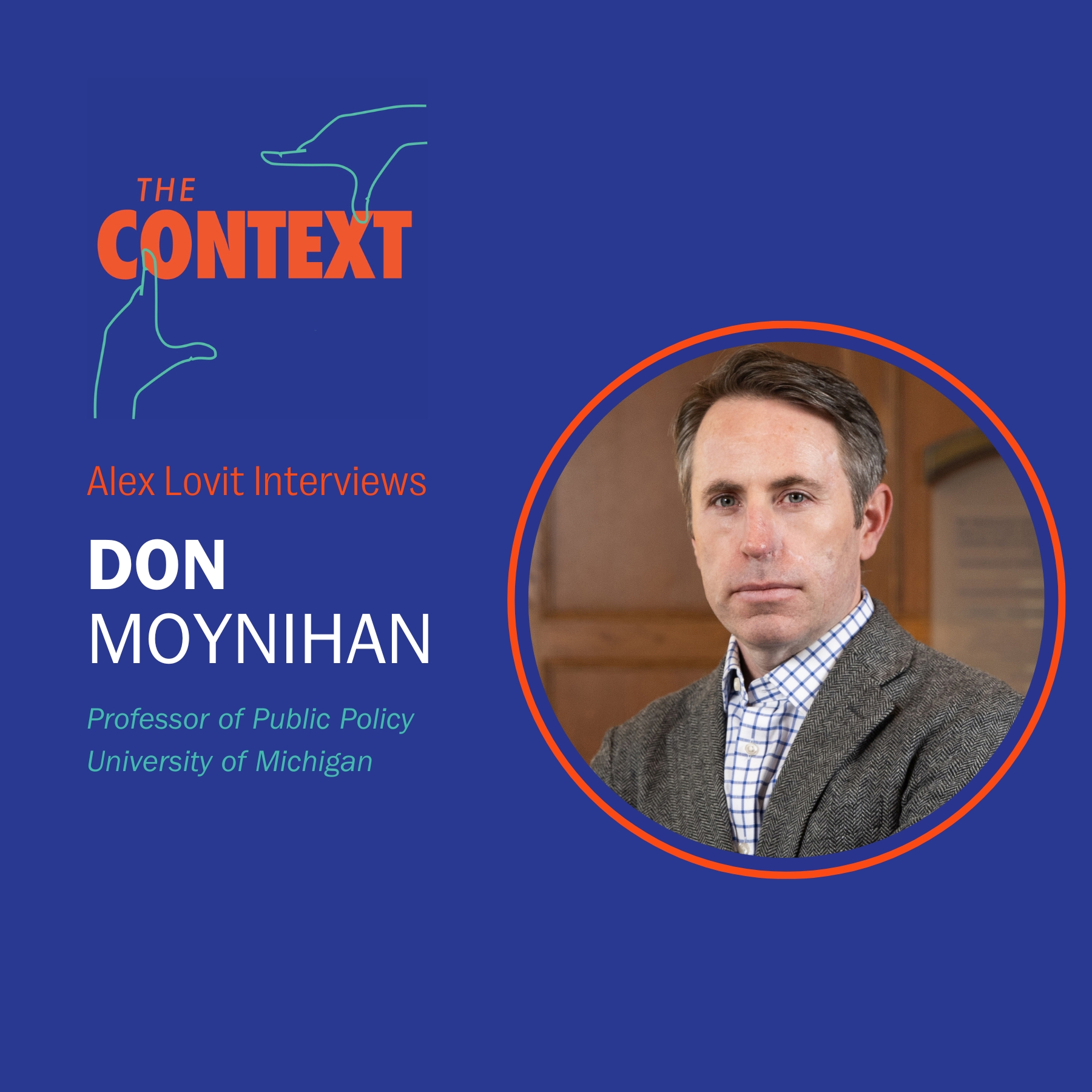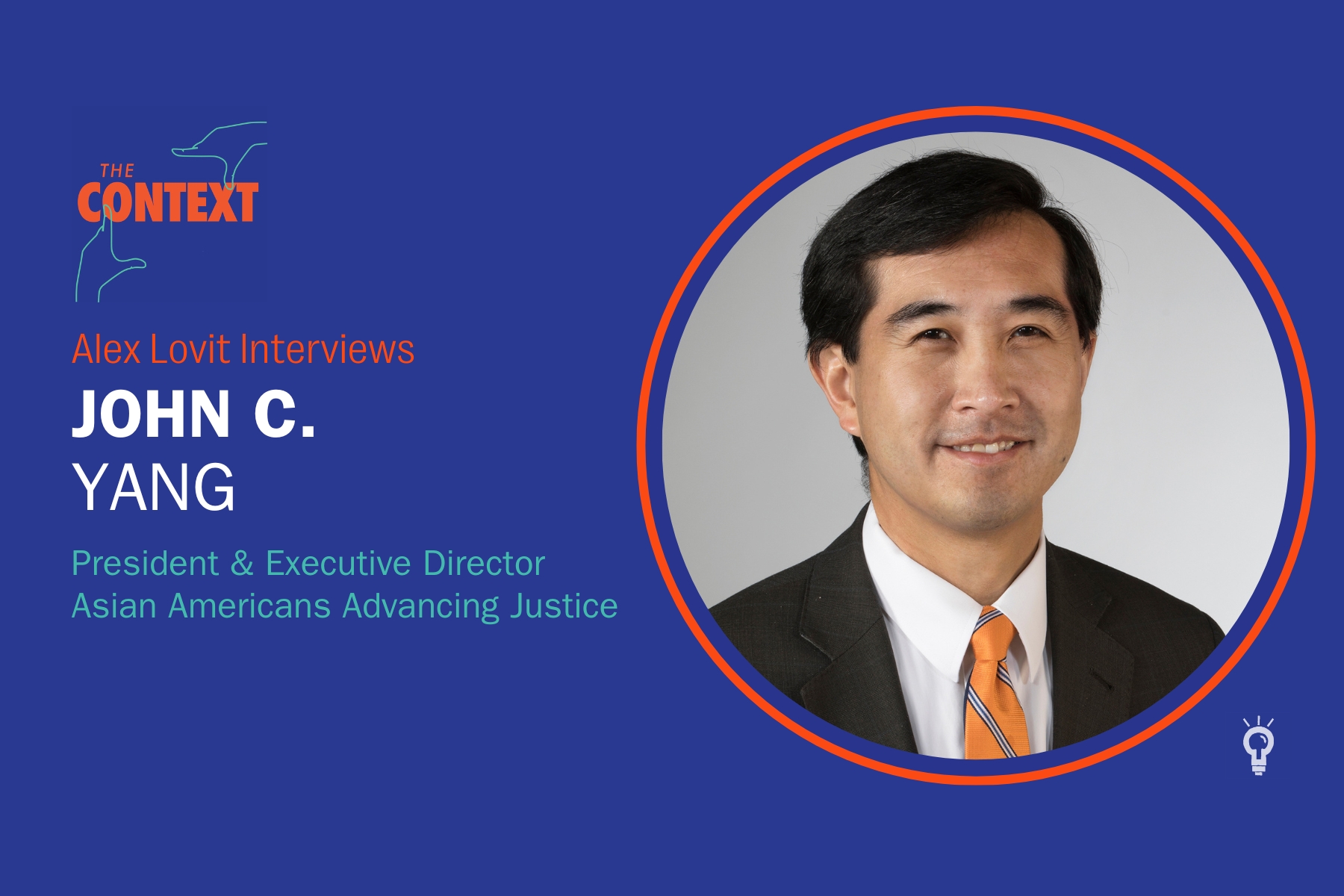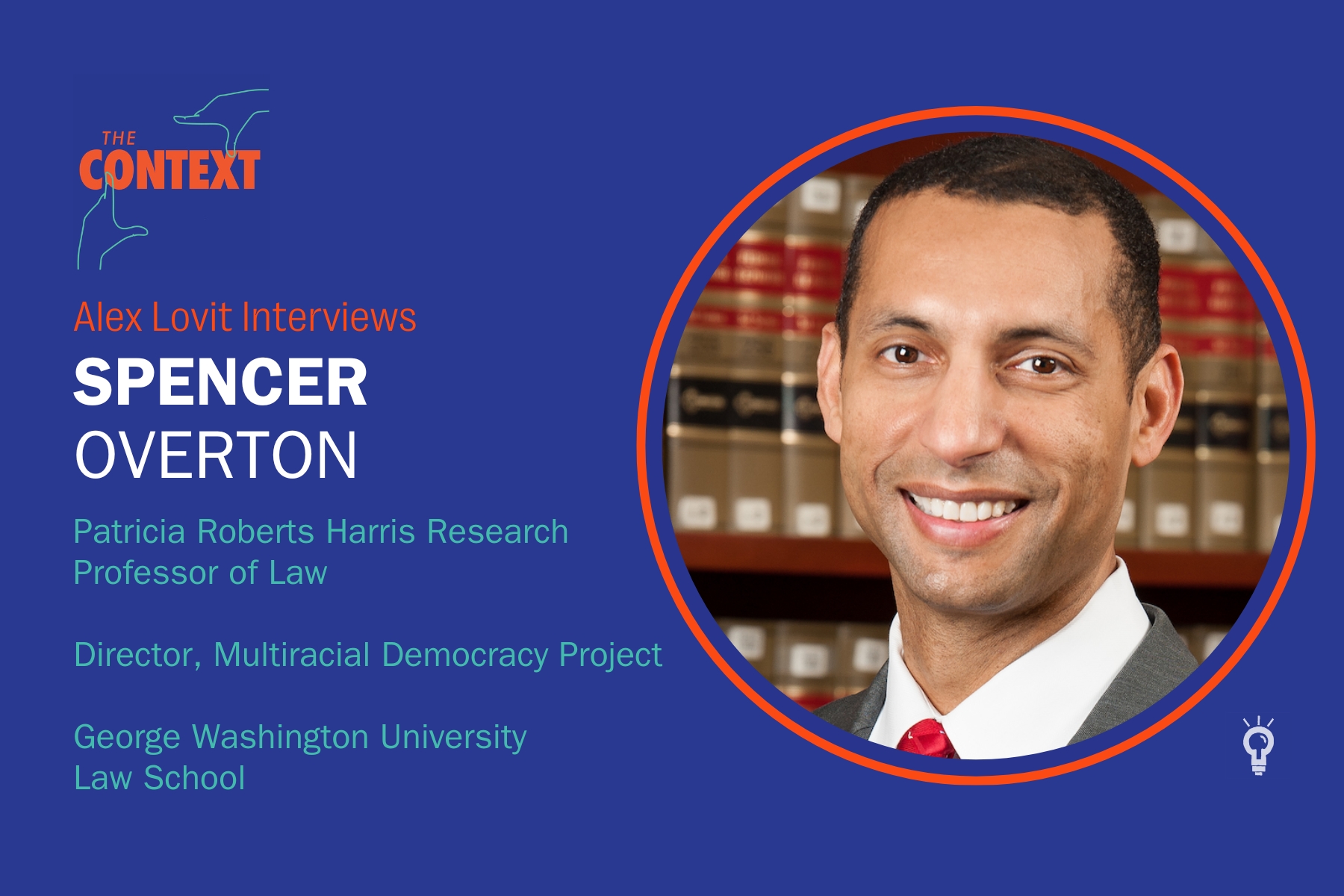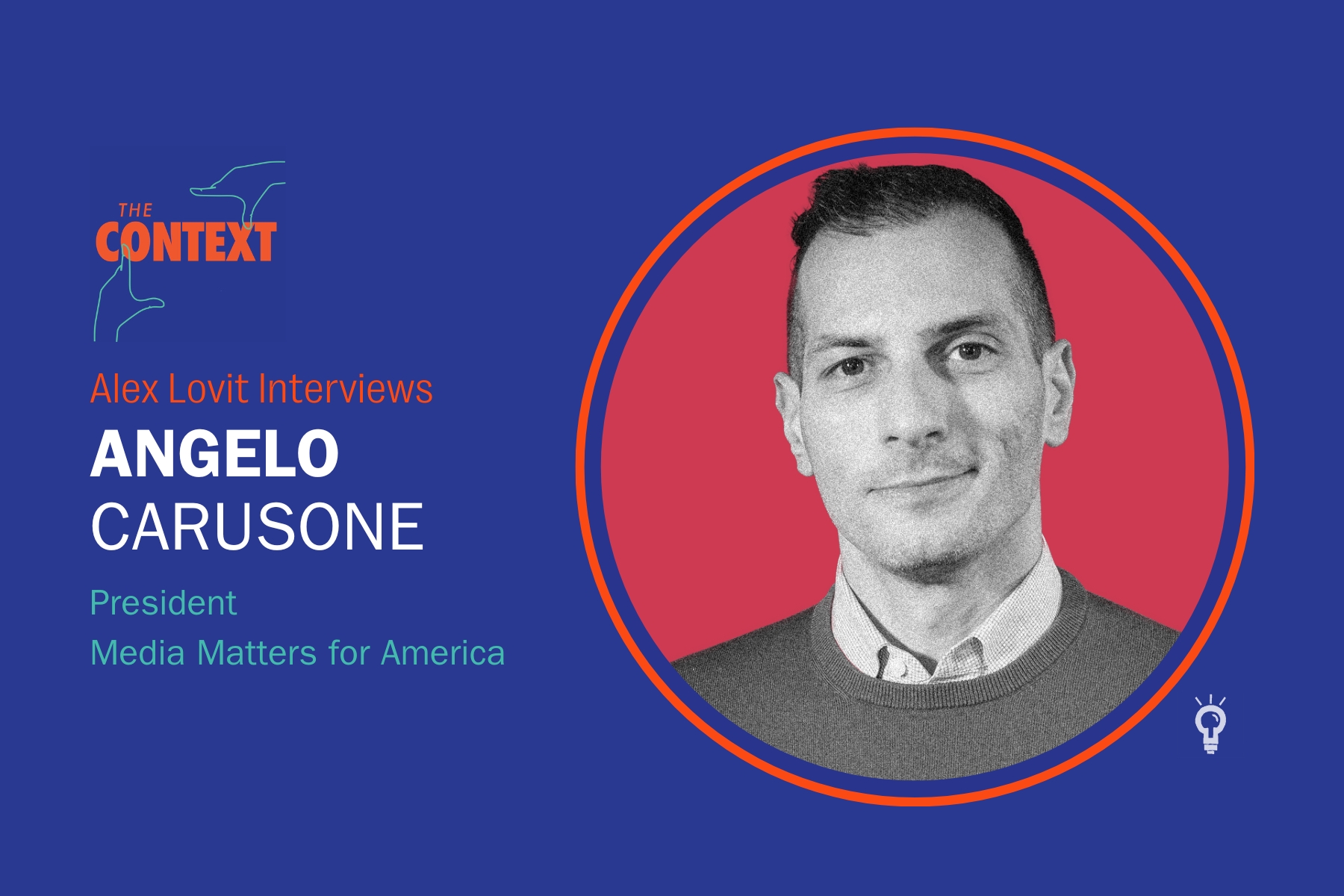Project 2025’s Threat to Democracy | SPECIAL EPISODE
Project 2025 is a transition plan for a second Trump administration created by the Heritage Foundation, along with other conservative organizations. Heritage has created similar documents for presidential transitions every four years since 1980. One aspect of Project 2025, which is distinct from these previous iterations, is a focus on personnel policy. Near the end of the first Trump administration, the White House issued an executive order establishing a new classification of federal bureaucrats, Schedule F. The intent was to allow the president to exercise more control over career civil servants by exempting them from civil service protections and making it easier for the president to fire them. Project 2025 seeks to take advantage of Schedule F by creating a list of vetted conservatives who can replace, or credibly threaten to replace, employees who previously would have been considered non-political. This would likely have negative effects both on the quality and efficiency of government services, and on democratic accountability.
Donald Moynihan is a public policy professor at the University of Michigan’s Gerald R. Ford School of Public Policy and codirects the Better Government Lab at Georgetown University. He previously served as the McCourt Chair for Georgetown University’s McCourt School of Public Policy and as director of University of Wisconsin-Madison’s La Follette School. His work focuses on the administrative burdens citizens encounter during interactions with government. In addition to his research, Moynihan is the president of Association for Public Policy and Management.

Share Episode
Project 2025’s Threat to Democracy | SPECIAL EPISODE
Listen & Subscribe
Project 2025 is a transition plan for a second Trump administration created by the Heritage Foundation, along with other conservative organizations. Heritage has created similar documents for presidential transitions every four years since 1980. One aspect of Project 2025, which is distinct from these previous iterations, is a focus on personnel policy. Near the end of the first Trump administration, the White House issued an executive order establishing a new classification of federal bureaucrats, Schedule F. The intent was to allow the president to exercise more control over career civil servants by exempting them from civil service protections and making it easier for the president to fire them. Project 2025 seeks to take advantage of Schedule F by creating a list of vetted conservatives who can replace, or credibly threaten to replace, employees who previously would have been considered non-political. This would likely have negative effects both on the quality and efficiency of government services, and on democratic accountability.
Donald Moynihan is a public policy professor at the University of Michigan’s Gerald R. Ford School of Public Policy and codirects the Better Government Lab at Georgetown University. He previously served as the McCourt Chair for Georgetown University’s McCourt School of Public Policy and as director of University of Wisconsin-Madison’s La Follette School. His work focuses on the administrative burdens citizens encounter during interactions with government. In addition to his research, Moynihan is the president of Association for Public Policy and Management.

Share Episode
Project 2025’s Threat to Democracy | SPECIAL EPISODE
Listen & Subscribe
Project 2025 is a transition plan for a second Trump administration created by the Heritage Foundation, along with other conservative organizations. Heritage has created similar documents for presidential transitions every four years since 1980. One aspect of Project 2025, which is distinct from these previous iterations, is a focus on personnel policy. Near the end of the first Trump administration, the White House issued an executive order establishing a new classification of federal bureaucrats, Schedule F. The intent was to allow the president to exercise more control over career civil servants by exempting them from civil service protections and making it easier for the president to fire them. Project 2025 seeks to take advantage of Schedule F by creating a list of vetted conservatives who can replace, or credibly threaten to replace, employees who previously would have been considered non-political. This would likely have negative effects both on the quality and efficiency of government services, and on democratic accountability.
Donald Moynihan is a public policy professor at the University of Michigan’s Gerald R. Ford School of Public Policy and codirects the Better Government Lab at Georgetown University. He previously served as the McCourt Chair for Georgetown University’s McCourt School of Public Policy and as director of University of Wisconsin-Madison’s La Follette School. His work focuses on the administrative burdens citizens encounter during interactions with government. In addition to his research, Moynihan is the president of Association for Public Policy and Management.
Alex Lovit: Welcome to The Context, a podcast about the past, present, and future of democracy from the Charles F. Kettering Foundation. I’m your host, Alex Lovit. The subject of today’s episode is Project 2025, a program from The Heritage Foundation and other conservative organizations to prepare policy and staffing guidance for a potential second Trump administration. The Kettering Foundation’s mission is to advance inclusive democracies by fostering citizen engagement, promoting government accountability, and countering authoritarianism. And we’re worried about Project 2025 because we see ways that it puts those goals at risk.
As you’ll hear about in this interview, a major component of Project 2025 and something that distinguishes it from presidential transition plans has created in previous election cycles is a focus on personnel. To quote Paul Dans, who served as the executive director of Project 2025, “Personnel is policy. Our goal is to assemble an army of aligned, vetted, trained, and prepared conservatives to go to work on Day One to deconstruct the administrative state.”
This replacement of non-partisan civil servants with political appointees could turn the federal workforce into a partisan tool, weakening accountability and eroding citizen trust and engagement. The removal of safeguards for civil servants would also weaken checks on executive power. A civil service made up of political appointees could embolden an executive who acts as a strongman. Recent Supreme Court decisions about presidential immunity and administrative independence only increase these risks.
Executive branch departments and agencies also play important roles in prohibiting discrimination and protecting voting and disability rights. Without a strong, independent administrative state, marginalized communities may not receive the protections they need, moving the country further from the ideal of inclusive democracy.
My guest today, Donald Moynihan, can help us understand these risks. He’s a professor at the University of Michigan’s Ford School of Public Policy, co-directs the Better Government Lab at Georgetown University, and is the president of the Association for Public Policy and Management. He previously served as the chair of Georgetown University’s McCourt School of Public Policy and is the director of the La Follette School of Public Affairs at the University of Wisconsin-Madison.
Moynihan has studied Project 2025 closely, and he spent much of his career researching how government can better serve citizens. In fact, I recorded an additional interview with him on that topic, which we’ll release as a future episode of this podcast. But since Project 2025 is so relevant to the 2024 election, we wanted to get this part of the conversation out before the election concludes.
Moynihan deeply understands how the administrative state functions, which means he also understands how it would be impacted by the changes proposed by Project 2025 in how federal appointees are classified, appointed, hired, and fired. He makes a convincing case that Project 2025 will damage the important role that career civil servants play in holding elected officials accountable while also likely decreasing the quality and efficiency of government services.
How might Project 2025 influence the federal agencies and services you rely on? And how would it affect American democracy? Stick around and find out.
Don Moynihan, welcome to The Context.
Donald Moynihan: I’m so happy to be here. Thanks for having me, Alex.
Alex Lovit: In this conversation, we’re going to be talking about Project 2025, which was spearheaded by the conservative Heritage Foundation. In many ways, Heritage and Project 2025 are skeptical about government institutions. And you’re someone who’s spent a lot of time studying how government bureaucracies function, how they interact with citizens. So as a way of starting this conversation, I wanted to read you a quote from the forward to a Mandate for Leadership, the policy advisory document that’s a major component of Project 2025. This is by Heritage Foundation President Kevin Roberts.
He writes: “There’s a reason why the private economy hues to the maxim ‘The customer is always right’ while government bureaucracies are notoriously user-unfriendly, just as there is a reason why private charities are cheerful and government welfare systems are not.” And this is his explanation: “It’s because private enterprises, for-profit or nonprofit, must cooperate.”
So I guess first of all, do you think that it is true that government bureaucracies can be unfriendly? And do you have an explanation for why that might be different than Kevin Roberts’?
Donald Moynihan: So I probably agree with more of Roberts’ assumptions than you might expect. So I think there are some inherent differences between public and private organizations that matter to how they operate. But I also think there are a bunch of differences that Roberts is not paying attention to.
So the most obvious difference is a public organization does not have a for-profit bottom line. And that makes it harder for it to measure performance. That makes it less of a necessity to be responsive to the people that it engages with. It won’t go out of business. On the other hand, we have privatized as much of the public sector as we can.
Like the stuff that is easy to manage and deliver to the public or is profitable, the government is not doing that currently. And you can debate on the margins, on what are—for example, schools fall into that category. But we’re not privatizing much more of the Department of Defense than we already do, right? Or we can’t privatize the Department of State.
So there are some inherently governmental functions that don’t really make sense to think about from the private perspective. There are also expectations we have of government that are different from the private sector that Roberts talks about. One is transparency. We want to simply know more about how public organizations operate. One is due process. The cheerful nonprofit that Roberts mentions in that quote you provided might decide they don’t want to serve people because of their religion or their gender identity. And they have a right to do that.
But in the public sector we expect that everyone is treated equally before the law. So there are more requirements that public organizations have to be responsive to values other than profitability. Where I think Roberts is also wrong is even though his stated [premise] is that governments can do a lot better in serving customers and providing better experiences to the public—I completely agree with that. And that’s a huge motivation in the research I do—he doesn’t actually have a solution for that in Project 2025.
Most of the policy goals that he is pursuing and in particular the goals around the administrative state would make the government less able to better serve the public than it currently is.
Alex Lovit: I want to ask about how people should think about Project 2025 and its relationship to Trump and what is this Heritage Foundation thing. So we’ve been talking about Kevin Roberts is the president of Heritage. It’s a conservative think tank. It’s been around for almost 50 years. They have been putting out these policy advisory documents for potential incoming conservative administrations since the 1980s, so long before Donald Trump got into politics.
So when Project 2025 became politically damaging for Trump, he tried to distance himself from it. At the same time, there’s only so much daylight he can put between himself and Project 2025. CNN has identified 140 different people who both served in the Trump administration and contributed to Project 2025. How do you think about that? To what extent should we read Project 2025 as a description of the likely policy agenda of a second Trump administration? How much of it should we think of as sort of a lobbying effort that may or may not influence the policies of a second Trump administration?
Donald Moynihan: I think it’s fair to characterize Project 2025 as the best and most detailed blueprint for how a second Trump administration will operate that currently exists. This is partly because Trump himself is incredibly wary of providing policy specifics. So he reduced the Republican Party platform this year. I think he cut it significantly so that it was just a couple of pages. There was no party platform in 2020.
His own policy goals are incredibly vague. I think this is because Trump understands once you get into the weeds of saying, “Here are my policies,” they are less popular with the public than he as a candidate is. So he very much tries to avoid specific except for a couple of like headline policies like build a wall. All of that said then, there are, as you pointed out, incredibly strong connections between Trump and Project 2025. I don’t think that’s an accident.
Heritage Foundation, which organizes Project 2025, is led by Roberts who is very much a pro-Trump individual. He was hired by Heritage because they perceived they were becoming less relevant in the era of Trump-defined Republicanism. The people who are leading the project, which up until recently included Paul Dans, were former Trump officials.
Project 2025 also started unusually early in this election cycle relative to past cycles because Heritage was worried about being outmaneuvered by newer think tanks that had been blossoming since the end of the Trump administration and were led by former Trump officials. So they wanted to take the lead in establishing themselves as the policy guiders for Trump.
They managed to get over 100 of those organizations to sign on to Project 2025 as well. So in key ways they are very much connected to Trump. Now, I think you have to make a distinction between Trump as candidate and Trump as a person who would govern. The Trump campaign I think is genuinely irritated with Project 2025. I think there’s real bad blood with Heritage Foundation because as they have said, Project 2025 is a pain in the ass for them.
It is nothing but bad headlines. But if Trump wins, he is not going to appoint his political campaign to run the government. He is going to turn to the people who have been working on Project 2025 because they really are the most experienced and the most loyal Trump-centered policy folks that are out there. So it is completely reasonable to then say let’s take a look at what these people are saying, and let’s judge a second Trump administration by these policy promises.
Alex Lovit: So one of the major pillars of Project 2025 is a lengthy document. It’s over 900 pages outlining policy advice for every major federal agency and department. It’s mostly pretty dry stuff, and even some of the most controversial positions are hidden behind complex, bureaucratic language. I’m wondering if you have any particular policies from that document besides Schedule F, which I want to talk about in a minute. But are there any policies that you would highlight as things that you think are particularly likely to happen in a second Trump administration [and] which you think the American public should be aware of.
Donald Moynihan: I would be exceptionally worried about the erosion of reproductive rights. So I don’t think they mentioned the Comstock Act in the document, but there is language about regulations that could be revived that would restrict access to abortion pills. And that to me jumps out as something where Trump can say, “I will veto national bans on abortion”—and maybe that’s true or maybe that’s not. But Project 2025 has a different plan for imposing a much broader constraint on reproductive rights that involves the Comstock Act from the 19th century, which was a law prohibiting the distribution of lewd materials and which more conservative lawyers think they can reinterpret to limit access to abortion pills being distributed across state lines. So that one really does jump out to me.
A second area that jumps out to me in the light of recent bad weather and hurricanes and disasters in places like North Carolina and Florida is the call for downsizing or eliminating NOAA, which is accused of engendering climate change alarmism. I did not read the entire document, but I did search for certain things. If you Google the term “climate change” in Mandate for Leadership, it is almost always mentioned in the context of alarmism or extremism or radical ideas of climate change.
It’s treated as a scary idea that is being hoisted upon the public by these ne’er-do-well scientists inside and outside government. The solution to climate change is not to fix the problem, but it’s to get rid of the scientists who are raising concerns about this as a problem.
Alex Lovit: Let’s talk about Schedule F, which is I know a particular area of concern for you. An area where we have particular reason to believe that Trump would institute it, because he already did it. In October 2020 at the tail-end of his last administration he issued an executive order establishing Schedule F as a new classification of federal employees, which would exempt them from civil service protections, make it easier for the president to hire and fire them.
A new classification to federal employees didn’t make a lot of headlines back in 2020 and 2021. News media was focused on the election, January 6th—you know, there’s other stuff going on. Not too many people paid attention when Biden reversed that order and ended Schedule F. So can you tell our listeners, why should they care about Schedule F. And how is it a threat to democratic government?
Donald Moynihan: Yeah, it’s useful to give a little bit of a background. So as you pointed out, it’s passed right before the election. It does not get a lot of attention. We have a bit over 2.1 million federal employees in the federal government. And of those, about 4000 are political appointees. So the career public servants have joined with the intent of being there for a long time, not serving a particular administration.
Political appointees are picked by presidents, serve at their pleasure, usually spend 18 to 24 months in government before they move on. So very different routes into government, very different experiences between the appointees and the career public servants. Schedule F would involuntarily turn more of the career officials into political appointees.
It would say, okay, you might’ve signed up because you were a scientist interested in regulation of food and drugs or climate change, but we are now going to make you something else, which is a political appointee who we can then fire if we feel you’re not a team player.
What this would do would dramatically politicize the nature of the American administrative state in a way that I think would be the most significant change since the civil service was created back in the 1880s. It would do this by removing the ability of federal employees to withstand political pressure. All federal employees have to take an oath to the Constitution, not to an individual president, to uphold the law.
But they would be placed in positions where they might have to think, if I say something here, if I raise a concern, am I going to lose my job? Let me give a specific example of how this matters. When Trump was impeached over the withholding of aid to Ukraine, the public servants involved played two roles. One was in warning the president that what he was doing was illegal, and the second is in providing information to the public about the president’s wrongdoings.
So it is illegal for the president to withhold appropriated funds if Congress has said you’re going to spend money on this. You have to spend money on that particular thing. And Trump did not want to spend money apparently because he was hoping to leverage resources that were going to Ukraine to get political dirt on his opponent.
At the time career officials at OMB and in the Department of Defense saying this is contrary to the law, what’s going on here? Trump’s own political appointees including lawyers he had hired at OMB came up with some secret legal rationale that the president has this imaginary power that allows him to do this. Now, of course when it becomes public, all of that goes away. No one believes in that secret legal rationale. But that was Trump’s solution to the problem.
Once Congress gets involved and starts to investigate, Trump tells his staff, “Do not cooperate. Do not share documents. Do not testify.” By and large, his own political appointees follow that directive. Most of what we know about what went on during that withholding of aid comes from the testimony of career officials. So they provided to Congress this important form of accountability and insight into what was going on.
So I think this shows how even if you’re not talking about the need for, say, expertise of career officials to weigh on things like regulatory matters or on national disasters, they serve a different role, which is about democracy and providing democratic checks within the executive branch: warning naive political appointees or maybe bad faith political appointees about where the legal boundaries are and then telling the public when those legal boundaries have been violated.
After the impeachment, to the extent that he was allowed Trump sought out and punished those career officials. He kicked one out of the White House. He ensured that the promotion of another was withdrawn. If he had something like Schedule F, he simply would have fired them. If something like Schedule F had existed at the time, we might ask ourselves would those officials have spoken up and warned the president that what he was doing was illegal? Perhaps not.
Would those officials have gone to Congress and be willing to respond to congressional subpoenas to testify? Perhaps not. So Schedule F has, I think, this two-pronged component where it reduces not just the quality of government but also the quality of our democracy.
Alex Lovit: A previous guest on this podcast, Alexander Vindman, talks about the story you’re telling there about the first Trump impeachment. So, listeners, go back and listen to Episode 14 if you want to hear a more detailed conversation about the events we’re discussing there by one of the people who was really deeply involved. I want to ask you a couple questions about numbers.
The structure of the U.S. government is in some ways normal, that you have this level of political appointees overseeing an executive branch of career officials. So there’s a lot of people that the government needs to hire to do the work of government, that you need to hire people that can rely on those jobs, that they’re not going to be turned over every four or eight years.
But at the top of that, as you said earlier, there are currently about 4000 appointees. You’ve said that that is unusual, that’s an outlier in the democratic world. That’s more political appointees than in other countries. Do you have a sense of why that came to be? Is it a problem? Is there anything we can do about it?
Donald Moynihan: The history of this is that when the U.S. finally created a civil service system in the 1880s, they modeled that civil service system on the UK experience and, like many things, borrowed from the dominant English-speaking model that we were familiar with, with the exception that we kept carve-out for political appointees at the top of the system. That was quite dissimilar from the UK.
That was a nod, I think, to the idea that political appointees bring some measure of democratic responsiveness. That’s the positive spin. The negative spin is that the predecessor to the civil service system was the spoils system where political parties used the public sector partly as a form of largesse that they could provide benefits to supporters including hiring them for public sector jobs.
The parties were loath to completely give up that particular set of benefits. So the civil service system gradually increased over time, but the parties always kept some number of appointees in place. That number of appointees is large by comparison with other countries. It’s not typical in other countries that the first four or five layers of leadership will be political officials. And it’s also been growing.
So back in the early ‘90s, Paul Volcker, the former head of Federal Reserve, was appointed by George Herbert Walker Bush to lead a commission on the future of the public service. At the time Volcker said, “There are too many political appointees. And as best as we can tell, they’re actually undermining the quality of government. We should have fewer of them.”
So in 1990 we had about 3000 political appointees. Fast-forward to today, we have about 4000 political appointees. So that number has increased by a significant amount even as the number of actual career public servants has remained basically flat since the 1960s. So we have historically more appointees than we had 50 years ago even though the number of actual career officials working in government is about the same.
So, yeah, I think there is this history of there political parties wanting this level of control over the bureaucracy. The way in which they have sort of made this work is they haven’t completely gotten rid of elements of the spoils system in place, but they’ve maintained a hold for a certain number of loyalists at the top of these public sector organizations.
Alex Lovit: You’re saying there that what Schedule F is, is a proposal to vastly increase the number of political appointees sort of at the top of that system. I think you’re arguing that it’d actually be better to decrease that number. Could you just give us a sense of the costs of the politicization of that executive branch? Why is it a problem to have so many political appointees at the top of it?
Donald Moynihan: Yeah, that’s a great question. I’ve done some reviews of what does the research say about this. Basically there are a couple of reasons why having more political appointees undermines the quality of government. One is that it becomes harder to recruit and retain very qualified professionals. So if you join the federal government and you find out that the political appointee is not listening to you, you’re more likely to decide you’re going to quit the public sector. That means you have less capacity and less expertise in government.
We also have evidence that when they are managers, political appointees are less effective than career bureaucrats in managing programs. As best as we can tell, the mechanism that drives that performance difference is that political appointees have less experience working in government.
So, for example, if they’re typically there for 18 to 24 months, many public sector programs are enormously complex to understand, let alone to run. So by the time that political appointees might be getting a hand on understanding what they’re actually doing, they move on to another job whereas people who’ve been there for decades have the institutional knowledge to not just understand the topic that they’re expected to manage but also how to get the levers of government working to ensure that policy is implemented well.
The other area of concern is that when you have short-timers in government, their commitment to public sector values may be lower. We see this maybe more in some other countries, but the element of corruption becomes greater in the context where someone maybe joins government for a short period of time and then goes back out to the private sector and tries to leverage those relationships in ways that are beneficial to their companies but not necessarily beneficial to the public as a whole.
There are certainly guardrails within the federal government to try and minimize this threat of corruption. But if you see a mass politicization where you go from 4000 to potentially 50,000 or more political appointees, it becomes much, much harder to keep an eye on all of the potential ways in which corruption could happen.
Alex Lovit: Well, let me ask one more question about numbers. As you’re mentioning there, the proposal for Schedule F is maybe it would increase the number of political appointees tenfold, from 4000 to 40,000 or 50,000. I’ve heard numbers as high as hundreds of thousands.
So if Trump does win this election, he does institute Schedule F, and a year from now listeners to this podcast are hearing, “Oh, 500 people got fired under Schedule F,” or, “A thousand people got fired under Schedule F,” those numbers might sound small by comparison, especially in comparison to a federal workforce that numbers in the millions. If that does come to pass, do you think listeners should think, okay, phew, dodged a bullet, it wasn’t so bad? Or that still dangerous?
Donald Moynihan: I think it is still dangerous. And here’s why: first of all, Schedule F is crafted in this very ambiguous manner, which gives the president almost unlimited power to expand this classification of political appointee. The “F” in Schedule F is a reference to a category of political appointee. There’s a Schedule A. There’s a Schedule B. There’s a Schedule C and so on.
But those are relatively small numbers of people. In the Schedule F executive order, there’s no number specified about what the topmost number of officials would be in that category. It’s basically anyone who has a policy advisory role. That’s very ambiguous language that could be interpreted to cover almost any white-collar worker in government.
So it could be 50,000. That number has been proposed by people who help write the executive order. It could be in the hundreds of thousands. What it does, though, is put the threat of reclassification for basically anyone working in government in policy circles. So even if you’re not reclassified, you will know if I put a foot wrong, I could be reclassified. Even if you’re not fired, you will know that if you have been reclassified to Schedule F, I could be fired.
So the potential threat is there even if the actual numbers of people who end up getting fired will be relatively low. I think what we’ll see is and what I’ve seen advocates of Schedule F argue for is sort of a heads on pikes strategy. So the most likely thing that’ll happen is if Trump comes into power, they will have a list of people that they will fire very quickly, as soon as they legally can. They’ve been compiling the names of some of those people for a while.
Then they will reclassify lots and lots of people and leave them with the knowledge that they could be fired at any time. Over time they will selectively fire people for displeasing them. One aspect of Project 2025 is that in addition to writing this Mandate for Leadership, they also have a project for recruiting potential GOP political appointees.
They’ve said the goal is to get 20,000 political appointees. If you only have 4000 political appointee slots, then that math doesn’t really work. So the long [work] plan is to find homes for many more of these appointees in government, which will mean removing some of the folks who are already career officials. So I think over time the number of people fired could be relatively low, but I think that might be a misleading statistic if you want to understand the way in which Schedule F is going to corrode the quality of American government.
Alex Lovit: You were mentioning there another pillar of Project 2025. So one pillar is the policy document, the Mandate for Leadership. And another is this program to evaluate the sort of conservative credentials, ideological credentials of applicants and create this database of potential conservative appointees. Is that new? So Heritage has been creating some kind of policy document for decades now, but have they done that kind of recruitment in the past?
Donald Moynihan: There’s always been some sort of informal use of folks from Heritage in administration. So I think something like 60-plus members of Heritage ended up going into the Trump administration. But the scale of the recruitment of potential political appointees in the thousands and tens of thousands, that is very much new. The effort to go to, for example, state fairs and recruit young conservatives or go to college campuses and try to pitch them on joining the federal government, that is new.
It’s being done at a much different scale than anything we’ve seen in the past. Again, notably this is led by someone who is performing a very similar role in the Trump administration, John McEntee, who was the head of the Presidential Personnel Office, was recruited by the Heritage Foundation to perform this role where he would look at the qualifications of these individuals.
What we know from when he was in government is that he looked at Trump’s own political appointees only really from the perspective of loyalty to Trump, not in terms of qualifications or ability or competence but whether they were on board with the MAGA vision of the world. So it’s another connection between Trump and Project 2025. It’s another way in which Project 2025 is promising to serve as a second Trump administration.
Alex Lovit: For people who have opinions about Project 2025, obviously one way they can express them is by voting in the upcoming election. But do you have any other advice for listeners? How can we ensure that politicians consider public opinion about these issues of administrative staffing and policy?
Donald Moynihan: I think one thing that has been missing from the discussion of Schedule F is the perspectives of the public. The proponents of Schedule F have said this is a mechanism to improve democratic responsiveness because we’re going to give elected officials more power, and they’re the only ones who are elected. You’ve heard of the term “unelected bureaucrats” a million times as a pejorative form of insult.
But when we ask the public, they’re actually quite uncomfortable with a more politicized version of administration. The Partnership for Public Service a couple of months back did some surveys about Schedule F asking if the public preferred a more partisan approach to managing government or one that relies on a non-partisan model. The numbers were overwhelming in favor of a non-partisan model. It was something like nine out of the 10 members of the public who favored this approach—and this was true both of Democrats, Independents, and Republicans.
So the numbers when it comes to the public on these topics really are much more supportive of keeping strong protections around the civil service system and not turning them into the sort of politicized tool of whatever president is in power at a given point in time. I think getting more public voices into the discussion here is important.
One of the things I’ve really struggled with, as a professor of studies is talking about it from a big picture perspective and then translating that into what does this mean for everyday life? There are ways in which people who just sort of know policies in a particular area might be better able to explain that question to family members or to other parts of their community by talking about what they know about, what will this mean for education or what will this mean for science or what will this mean for public health?
So, for example, I think it’s very likely that as the attention to scientific consensus declines among scientific agencies, that will reduce the quality of government. Or if you have less competent officials leading natural disaster response, you will have many more people put in harm’s way. If you have people who don’t believe in climate change or don’t believe in vaccines leading agencies that rely on scientific input, it’s going to put the federal government’s ability to respond to climate change-related crises or public health crises back 10 or 20 years.
There are real ways that this matters to the public, but it’s getting from this sort of weird-sounding Schedule F type language to being able to explain those impacts. That’s where if you’re listening to this you probably know something about the way in which government works and could be damaged that you can explain to others or explain to your local representative.
Ultimately to solve this problem, Congress needs to get involved. And Congress has sort of sat on its hands when it comes to civil service modernization since 1978. It hasn’t passed any new laws that are really updating the system. It’s allowed the threat of Schedule F to occur even though I don’t think this is actually what Congress wants, but because of polarization and because of the influence of Trump, it has allowed this threat to loom large in the last couple of years.
So I think also if you talk to members of Congress or feel like you can email or leave a voicemail at your local congressional member’s office, emphasizing your opposition to Schedule F would be an effective thing you could do.
Alex Lovit: Well, thank you, Don Moynihan, for helping me understand how government actually works and helping our listeners understand what they can do to help improve it.
Donald Moynihan: My pleasure. Thank you so much for talking.
Alex Lovit: The Context is a production of the Charles F. Kettering Foundation. I’m Alex Lovit, a senior program officer and historian with the Foundation. Melinda Gilmore is our director of communications. This episode was produced by George Drake, Jr. If you like the show, leave us a rating or a review or recommend us to someone. The Context is normally a bi-weekly podcast, but the episode you just listened to was released during what would normally have been an off week since we were trying to squeeze one more in before the U.S. election.
So we’ll have another episode for you next week, November 5th, which is Election Day here in the U.S. That one is a conversation about democracy in Argentina, a country which has a similar political system to the United States and which has experienced the collapse and rebuilding of their democracy over the course of the last century.
There are lessons that the United States can learn from that story I hope without going through Argentina’s experience of violent authoritarianism. We’ll be back in this feed with that conversation next week.
The views expressed during this program are critical to us having a productive dialogue, but they do not reflect the views or opinions of the Kettering Foundation. The Foundation’s broadcast and related promotional activities should not be construed as an endorsement of its content. The Foundation hereby disclaims liability to any part for direct, indirect, implied, punitive, special, incidental, or other consequential damages that may arise in connection with this broadcast, which is provided as-is and without warranties.
Transcripts are created on a rush deadline by a Kettering Foundation contractor and may contain small errors. The authoritative record is the audio recording.
More Episodes
- Published On: December 2, 2025
The news is full of stories of political crisis, and these stories are fed to us with speed and intensity through social...
- Published On: November 18, 2025
The Trump administration is trying to restrict who gets to be an American: who can be in the country, who has citizenship,...
- Published On: November 4, 2025
Recent advances in artificial intelligence have drawn a lot of media attention. But little of this has focused on how this new...
- Published On: October 21, 2025
How did right wing voices take over podcasting? Media analyst Angelo Carusone joins host Alex Lovit to discuss how the online media...
- Published On: October 7, 2025
Nonviolent movements are more effective at combatting authoritarianism than violent resistance, according to research from today’s guest. Maria Stephan joins host Alex...
- Published On: September 23, 2025
Deva Woodly joins host Alex Lovit to discuss the importance of social movements for American democracy and the role they can play...





